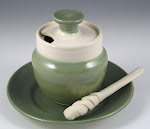A machine-made pot is a more perfect pot, light and absolutely regular in form. Everyone’s place setting is exactly the same. We humans crave some order and balance. Machine made dishes also stack better in the cabinets, as my first college ceramics teacher, Dave W. Jones, pointed out. (He was a very fine potter, trained at that interesting juncture when Danish modern design and Peter Voulkos met with a bang and a slash in the 50s.) Dave was a realist about functionality. All the same, he pursued the art and craft of making pottery by hand, and so do I, because there is no real spirit in a machine made pot.
Yesterday I made a seder plate; not my first by any means. The seder plate has been an evolutionary item in my studio for at least 20 years. Its function defines it, like any item of Judaica. It is meant to sit in the middle of the table at the Passover seder and contain symbolic portions of the special foods of the meal. The first started out long ago on my wheel, too small and heavy, the design somehow never becoming “right” through modifications, until I took some time to plan it. I drew some 6-petaled flowers and abstracted the forms till I had one I liked. I made paper and upholstery foam templates and other tools to accommodate production. I make the plates from slabs now, instead of on the wheel. They are lighter, larger and I can make similar multiples. Making seder plates over the years is symptomatic of all of my journeys in clay, a very slow and sort of steady trip.
When you think of "accidents" of art, here is an analogous hypothetical situation to ponder:
Someone gives you a nice little box, and says, Fill this box. Do not overfill or underfill it. Fill it so that it remains a container, but make it more by virtue of what is in it, how well it contains, how it closes and opens, what it looks like. Go!
You fill it with rocks. The rocks are from the coast of Maine, all rounded and smooth blues and whites and grays, and so beautiful. They fit in the box just so. You admire the contents of the box and close it. Later, when you pick up the box to put it away, you stagger and the box bends a little under the weight. They look good in it, but rocks are the wrong load for this box.
You start again. You take the rocks out of the box, fill it carefully with your collection of hat feathers and cover it, and when you lift it, it is light. You open the box and a draft lifts feathers and settles them all over your sofa. The remaining feathers are all meshed together and you can’t sort out individuals by eye. Feathers are better in something other than this box.
So you say, the heck with this experiment, and the heck with the guy who gave you the box. You fit your jars and tubes of paint and pigments into the box. You needed to neaten up your easel area anyway. You have now used the box in a non-decorative way. You expect nothing more than a utilitarian arrangement, and you go have dinner.
Tomorrow you return. You open the box and you are surprised. The paint tube labels and the pigments in their clear jars are an explosion of color. The box smells interestingly of linseed oil. You find each item at a glance. This is a utilitarian arrangement, but also- Yow!- a still life. Now the box is part of a functional composition. Art! Your five year old could do it... couldn't she? Maybe- up to this point. Maybe not once canvas and brushes get involved.
You- hey, you with the box- already had an artistic spirit and a creative eye, which were working unconsciously as you gave up and accepted the box as a component of a life situation. Function balanced with- and this is the crux of the thing- the unnameable force from your arty ole head, and gave you your surprising still life.
This is really a clay story. Latent knowledge and conscious knowledge flow together as a potter works, aware of the functionality of each piece, our own voices coming through ever more strongly and even unexpectedly as we gain experience. Then just working through the everyday of clay and bringing one more challenge into the equation sometimes catalyzes into the Yow! moment.
Yesterday's seder plate is on a shelf in my kiln, drying. It's my best one yet, the most like my planned design but also with spontaneous elements. Don't want to move it while it dries, or I would take a better picture for you, but check out the raw pot in the picture. Who knows what the next one might have that this one doesn't.
Keep on doing whatever good thing it is you do!
Subscribe to:
Post Comments (Atom)

I like the seder plate very much. The cupped nature of the design gets rid of the fussy baby cups that come with so many seder plates, including some of your own manufacture :) More broadly speaking, I think the increased standardization that you've incorporated over the last few years, with the forms and templates, has been great.
ReplyDelete